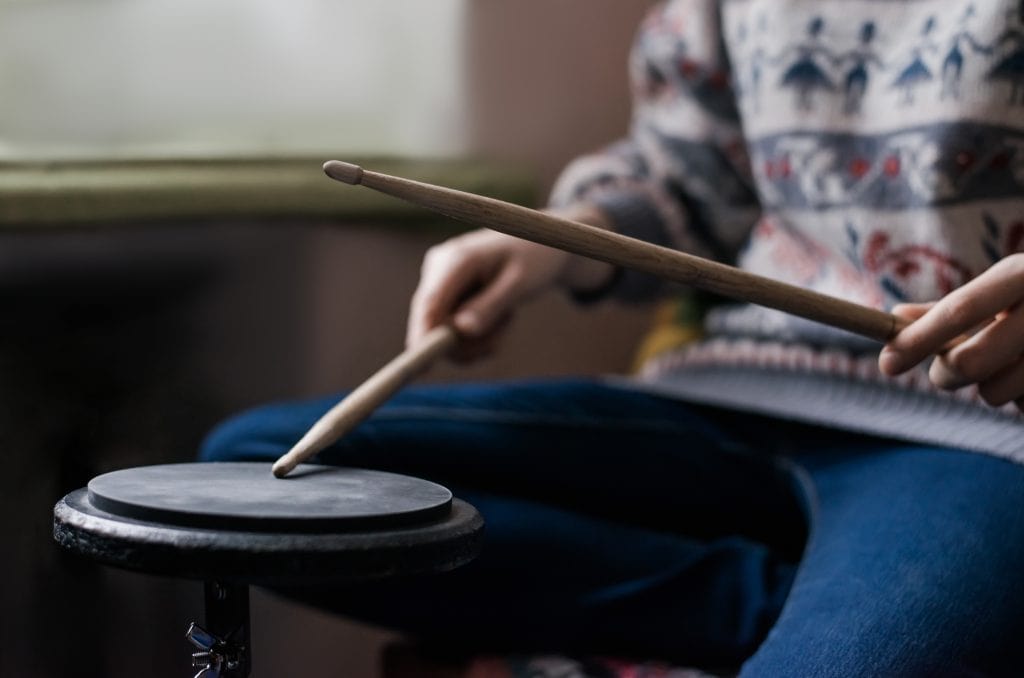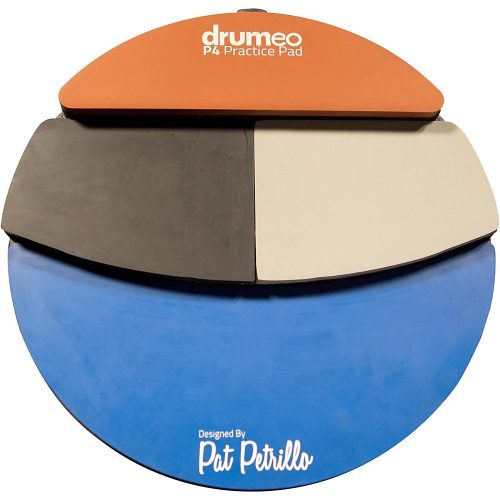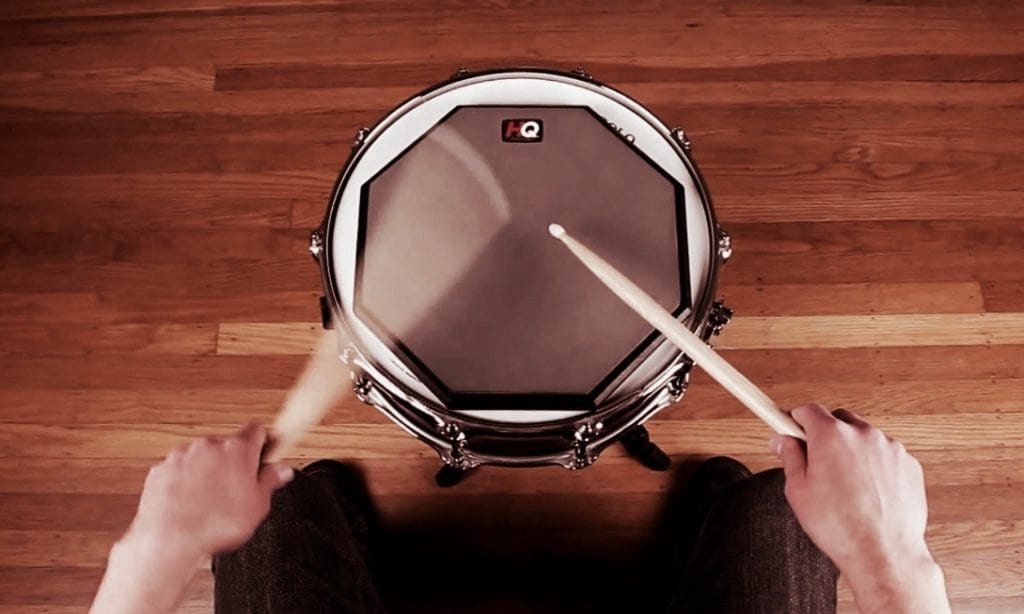The drum practice pads, oh those wonderful things that help each drummer increase their performing level.
Almost every drummer uses one and advises beginners to get one for practising. If you are one of those newbies, I will thoroughly explain how to use a drum practice pad.
From what and why to use drum practice pads, clean them, and when to replace your pad.
Stay tuned, and if you have any questions whatsoever, please feel free to ask, and I will answer you as soon as possible!
Enjoy!
What Are Drum Practice Pad?
A practice pad or drum pad refers to drummers’ equipment to practice in their home environment.
Other precisionists utilize this instrument, and it is also used during performance warm-ups.
It basically represents a drum imitation that plays and feels like a real drum but doesn’t produce a lot of volumes.
Most of them are pretty lightweight and small in size, making them convenient and handy for practicing at home.
Why Use a Drum Practice Pad?

Practice pads have a lot of advantages, and those are the exact reason why and how to use a drum practice pad:
- Very convenient for practicing
- Low in volume – great for drummers with neighbors & kids
- Very light and pretty small thus, portable
- You can hear each mistake you make when drumming
- Make progress easily
If I have to choose the two most important reasons to use a drum pad, it has to be its convenience and the ability to track your progress.
The convenience comes from the ability to play whenever and wherever you want while producing such a low noise. So practice your rudiments while commercials are on or on your break from your work!
Tracking your progress – You can hear and see your weaknesses, as well as where you need to improve. For example, when receiving a much quieter tone, you’re able to hear more of your playing, as well as hearing the metronome more clearly.
What Is a Drum Practice Pad Made of?
Practice pads can be made of a disk of mylar or even some other material used for drumheads, which is stretched over a rubber or foam substrate. All these materials are held together with plastic or a rim of metal.

Mylar
Other practicing pads use a thin layer of elastomer, typically synthetic or natural rubber ranging in density, to provide a playing surface. Typically, a rubber surface is placed directly on top of the drumhead or attached to the top of a solid substrate. The rubber acts as a reflector of a mallet when it’s struck similarly to a real drumhead.

Elastomer
The third type of material is a disk of mesh stretched over a frame.
Compared to mylar and rubber, the mesh is a bit quieter, and when tightened or loosened in the frame, it simulates different types of drum heads!

Mesh
What to Practice on a Drum Pad?
Practice your rudiments!
You should approach it pretty simply.
Work on fairly easy stuff like:
- Singles,
- Doubles,
- Paradiddles,
- Six stroke rolls, and
- Flams
Overall some basic rudiments!
Before you start with your first kicks on the drum pad, you can practice a little bit on your pillow to build up your chops.
Let your hand technique be really loose and proficient!
If you are unsure where to start and how to do it, simply seek out some tutorials online, there are plenty of them, plus they are free of any charges!
That’s the first and most important thing to do when getting your practice pad. Then, when playing your rudiments simultaneously, you will also perfect your drumming technique!
How Long Does a Drum Practice Pad Last?

Your drum pad will last as long as you take care of it properly!
The pad will be worn out if the playing surface is worn out to the point that it peels off in irregular chunks, making it impossible to play.
Therefore I can’t tell you e.g.g. After 5 years, it’s time to throw the drum pad away!
However, there are two things you should be aware of:
First, practice pad membrane – these tend to wear out, so you should change them every six months up to a year, depending on your strokes.
Rubber drum pads – these ones are here for the long run, which means that they can serve you up to 20 years!
The drum practice pad longevity depends on:
- How often do you use your practice drum pad,
- How good you take care of it, and
- What type of practice drum do you have
Practice Drum Pad What to Look for?
The playing surface – It is the most important thing when looking for a good drum pad since it determines how your stick responds upon striking it, as well as the sound it produces.
To put it simply, practice pads offer either one or two playing surfaces, better known as single and double-sided, made from either wood or plastic.
Here’s some advice!
If durability is the most important for you, then seek out for rubber drumming pads like Drumeo’s P4.
Weight and portability – If you practice mostly at home, portability shouldn’t be a major consideration. In any case, you should invest in a pad with a larger surface area. It is because it offers a number of benefits when drumming, but albeit at the expense of space.
Besides that, weight is also a big factor when choosing the right pad for you.
The smaller and lighter practice pad the more instability problems when practicing.
They tend to shift and slip from their positions very often.
For e.g. Knee Drum Pads – Steve Smith backstage pad is the ones you want to get when traveling, but for home conditions opt for the ones with a bigger playing surface like Evans RealFeel Practice Pad, in order to avoid instability problems!
Silence of a drum pad – This is especially important if you have neighbors, if you live with your family, have kids, or anything related to that. To make as little noise as possible, opt for a quieter drum pad like Mesh Drum Pads.
My recommendation is Sabian 14″ Quiet Tone Mesh Practice Pad because it delivers quiet performance without producing noises like a typical drum kit!
Sound versatility – The ideal drum practice pad should be flexible and adaptable, offering an easy-to-use experience. Whether you are a pro player or even a beginner you will benefit from it either way!
What Size Drum Practice Pad Should I Get?

For, e.g., a 6-inch pad is not recommendable for adults since you won’t feel comfy and reduce strokes options. The benefit of the 6-inch pad is that it’s good when traveling. However, it is susceptible to moving around when playing because of its lightweight.
That’s why adults should seek out at least a 10-inch drum practice pad or, even better, a 12-inch pad because it is a great size and can be mounted on any regular snare stand.
How Often Should I Replace a Drum Practice Pad?
There is no strict time when replacing the practice drum pad.
But, some signs that you should be aware of are:
- Obviously worn out drum pads
- The pad does not produce sound quality as it was when it was initially bought
- Scratches and grazes that cannot be fixed
- The pad does not simply suit your needs or your drumming preferences
How to Clean a Drum Practice Pad?
Cleaning your drum pad is not something complicated, and you won’t need any special equipment for it.
Let’s check how you can clean it simplest yet most effective way.
- Take some soft washcloth that doesn’t consist of rough materials
- Use some water or even Windex (or a similar product)
- Spray the Windex on your washcloth and clean off the dirt and residue from your pad
- Do not pad but gently wipe it with fine strokes
- You can even use goo gone to clean any additional goop
- After using the goo gone, always wipe it out with Windex to avoid a stinky pad.
What Drum Practice Pad Should I Get?
Before you decide to buy your drum pad, you need to ask yourself some questions:
- How much do I plan on spending on the drum pad?
- What size drum pad do I want/need?
- How quiet do I need it to be?
- Do I need a portable drum pad?
My recommendation is Drumeo P4 since it is very versatile, a great size for adults has even 4 playing surfaces, and its design is pretty unique.
However, this drum pad requires a bit of a bigger budget!
Therefore, choose the drum pad depending on your needs and preferences. And, since all of us have different needs, check out the list of the best practice pads, and find out which one suits you the most.
Summary
Drumming pads are those things that will help you practice your rudiments and techniques when you are not able to play on your conventional drum kit.
They are not instruments; as you can see yourself, it is a piece of equipment for drum practicing.
From my experience and things that I’ve learned, I hope I have helped you with some basic questions that many young and even older drummers tend to ask. For example, from what drum pads to get to, do you really need one to use a drum practice pad!
My name is Denis. I am a drummer, percussionist, music enthusiast, and blogger. Drums have been my passion for 15 years now. My idea is to write about the things I like and I am interested in. I want to share my drum passion with fellow musicians who walk, talk, and breathe drums.







Great article Dennis
i found it since I wanted to clean my Real Feel from scratches and I trie Goo Gone and water…..It is MUCH better but has white lines on the edges… Will apply some Windex . You appreciate your craft if you take care of your tools…Well written article
Thanks Vin, I am glad you like it. Cheers
[…] Use some water or even Windex (or a similar product) Spray the Windex on your washcloth and clean of… […]